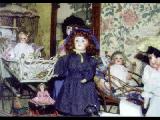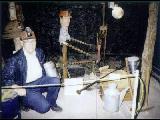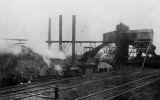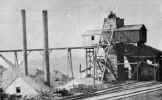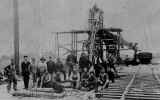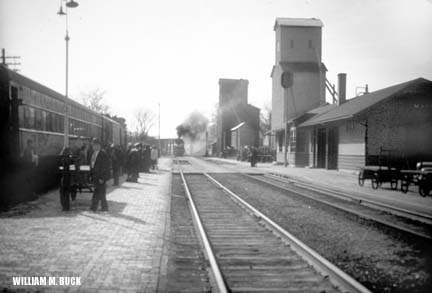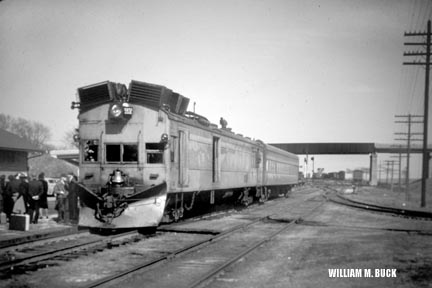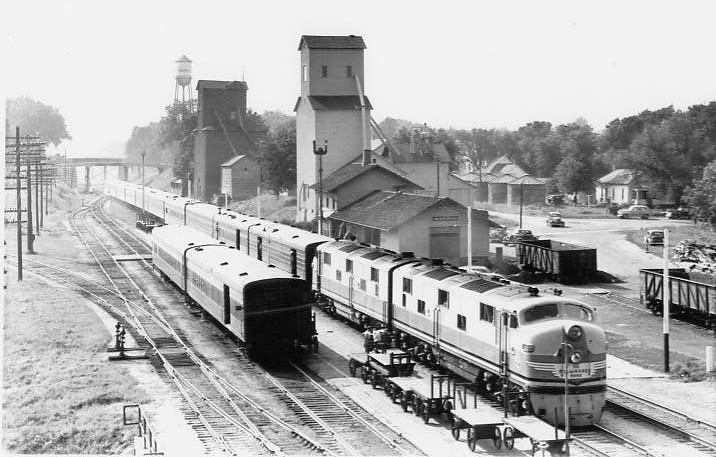Community Pride - - a Sign of Progress!
Madrid Historical Museum Cemeteries in Boone County |
|||||||
| Josephine Pagliai | The Story of growing up in Early 1900's in Madrid Iowa Childhood Remembrances | ||||||
|
|
|
||||||
|
|
|
||||||
|
|
|
||||||
The Madrid coal field was situated in the southern portion of Boone County and extended into northeastern Dallas County as well as northwest Polk County. Most of the mining however occurred along the Des Moines River in Boone and Dallas counties. Mining in the Madrid area before the 1880's was on a small scale with usually no more than three men working at a mine. Greatest production occurred usually in the fall and winter seasons, but tonnage varied with different seasonal periods. During the 1930's and 1940's, many small mining operations, employing 10 men or less started again. Most of the mines were located along the Des Moines River and supplied coal for local people and businesses. The mines were similar to mines that operated in the late 1800's with the exception that gas engines replaced the steam and horse power in some of the mines. Scandia Coal Company Mine Number One-was owned by the Carpenter Brothers in 1906 but at that time a shaft was driven into the "lower" horizon coal bed under the supervision of H. Zook. Scandia acquired the mineral rights for 1400 acres, marking the beginning of the, largest scale coal mining in the Madrid area. Operating under the room and pillar plan, a steam engine provided the power for the lifting elevator and ventilating fan. Coal was then shipped on a Spur line from the old Chicago, Milwaukee and St. Paul railroad line between Madrid and Woodward. The mine was apparently abandoned in 1917. The Zook Spur Mine - the Scandia Coal Company Mine Number Two - located one and one-half miles south of Madrid at Zookspur was opened in 1911 and was similar in operation to High Bridge and Scandia Number One except that it was equipped electrically. H. Zook was mine superintendent until 1917 when he was replaced by Owen Reese, son of W. J. Reese, who owned Reese Brothers Coal Mine at the turn Of the century. Coal from this mine was shipped to various parts of the state by means of the Chicago, Milwaukee and St. Paul railroad, Boone branch. Scandia Coal Company Mine Number Three-was opened in 1916 and was located one-quarter mile west of the J. R. Strange and Sons Coal Mine. H. Zook was also superintendent of this mine. Good quality coal was found in this mine; the latest of mining equipment was used and all foreseen great potential from this operation. Work at the mine halted in 1917 when the Des Moines River broke into one of the passageways and flooded the mine. Scandia Coal Company Mine Number Four - was the largest mine in operation in terms of total tonnage produced, and was also the mine in operation the longest, lasting from 1916-1943. Located one-half mile south of the city limits of Madrid, Owen Reese served for 20 years as mine superintendent before C. T. Carny assumed the position. Electrically operated, the annual output of the mine was 250,000 short tons. Upon its closing in 1943, the mine still produced 67,000 tons of coal. The High Bridge Mine - Reese Brothers Coal Company, High Bridge Company and Scandia Coal Company Number Five - Scandia Coal Company Number Five was owned by the Carpenter Brothers, purchased by the High Bridge Company- and renamed the Scandia Coal Company, Mine Number Five in 1926. Owen Reese served as mine superintendent until it was abandoned in 1931. Eagle Mine - Scandia Coal Company Number Six - operated from 1926-1939. Located two miles east of Madrid on a spur track from the new Chicago, Milwaukee, and St. Paul Railroad, the mine was operated electrically and used the room and pillar method of mining. The shaft was sunk by the Sayer Brothers of Des Moines and its average tonnage was 50,000 short tons. Around l926 when the first #6 mine shaft was dug between Ed Hooks farm and (Monkey) John Peterson's farm east of Madrid, the hole filled with water a little so the crew went to eat their lunch, hoping the water would subside and they could continue. When they returned, the pit was half full of water and all their tools were under water. They had hit an underground river. When the water ran down into the mine shaft it picked up a lot of sulphur from the digging which turned the water to an ugly orange color. It ran into a tile line and into a creek. The creek ran through a nearby farmer's land. The farmer had mangy hogs but when the hogs wallowed or rooted in the muddy orange water in the creek, the mange healed up. Later they dug another shaft further away from the first one until they found a vein of coal. They had been mining for some time and were about l/2 mile from the main shaft when they came to the Anton Larson farm where Noah Swanson and his family lived. The Swanson brothers had to haul water to the crew that was drilling down to the tunnels so they could keep the points of their drills cool. They began to have more water problems so they dug down and put a pump in. The pump ran continually. They pumped it into a tile that ran into a creek. In later years, the miners dug as far north as Fred Johnson's farm and Joe Sandberg's farm. There was a lot of coal between Madrid and Slater but it couldn't be mined because there was no roof. No. 6 mine and no. 4 shaft connected at Forslund's farm l/2 mile north of 2l0--north of what was Merrill Sundberg's horse corral at one time. No. 4 mine didn't have enough air so an air shaft had to be dug and put in near Art Boyd's farm south, east and about another l/2 mile south of Madrid. The man who did the dynamiting at No 6 lived next door to where Wilcox printing is now. (in l998) He would leave home at 2:00 p.m. Where the Noah Swanson family lived they would start feeling tremors and the house would shake at exactly 3:00 every working day. They said you could set your clock by it. Driscoll/Blythe Mine - Located at the base a steep bluff four miles north of Madrid along the Des Moines River, this mine was apparently in existence for some time before it was included in a mine report in 1906. The second horizon (layer) of coal was worked, and it outcropped at nearly the same level as the water in the Des- Moines River. A tramway was built to haul the coal from the mouth of the mine to the top the bluff and the power was provided by a small steam engine. The slope was 100 feet long by 1907 and reached the three-foot average coal bed three feet beneath the river level. The mine does not appear after the 1907 report Robert Porter Mine - drift mine operated one mile west of the Knox mine. in northern Cass township until 1894. This mine, along with the one owned by the Knox Brothers was one of the earliest in the area. Both mines were opened only during the winter months and employed about six men. Wisecup Bank - A drift mine (almost horizontal passageway in a mine along a vein of coal, ore, etc,) located in the same area as the Driscoll mine. The passageway measured 300 feet by 1907 and a tramway system pulled by horses was used to haul coal from the mine to the top of the bluff. The mine apparently ceased operation by 1908. Knox Brothers Mine - The Knox Brothers Mine or Knox Bank - located in the same vicinity as the Robert Porter Mine and Wisecup Bank existed as early as 1888. The coal bed was exposed on the side of a bluff 75 feet above the Des Moines River with horses providing the necessary power to haul the loads up the bluffs. The name was changed to the William Knox Coal Company around 1900 and William Knox was named mine superintendent. A new mine was opened shortly after and utilized the room and pillar plan of working. All coal was sold locally and the mines were apparently abandoned by 1907.
Lincoln and Sons Coal Mine J. R. Strange and Sons Coal Mine - Tabor Shaft was the third: largest mining operation in the Madrid area around the turn of the century. Originally named the Tabor Shaft, the mine had a shaft depth of 43 feet and a coal bed average thickness of 2 1/2 feet. Using the longwall mining method, a furnace provided ventilation and horses were used in hauling coal. Fifteen men were employed during the winter months of 1899 and this was the last year of its operation. The J. R. Strange and Sons Coal Mine was located on the west side of the Des Moines River near Chestnut Ford, a mining town from 1885-1898, 2 1/2 miles southwest of Madrid. Chestnut Valley Mine - owned and operated by Ole Olson was in operation from 1901-1904. A shaft mine of 112 feet deep, the coal bed was located one-half mile north of the Strange mine and worked the same coal bed. The drill for the Chestnut Valley mine was discovered a coal vein four feet thick at a depth of 171 feet, that became known as the "lower" horizontal coal bed of central Iowa, but coal was never exploited from this mine. Carpenter Coal Company - This mine was the largest found in Dallas County in terms of coal tonnage at the turn of the century. It was the first shipping mine in Dallas County and was owned and operated by two Carpenter brothers. It was located on the old Chicago, Milwaukee and St. Paul railroad between Madrid and Woodward and was one mile north of Scandia. Like so many others, it was a shaft mine using the longwall plan of working and used steam power to ventilate the fan and raise the hoist. Mining at this particular mine lasted only from 1899-1900 but these same two brothers sank shafts under the trade name of Scandia Coal Company and it became the most influential mine in either Boone or Dallas counties. Phillips Fuel Company - Phildia - The discovery of large amounts, of coal in the Madrid area around 1906 prompted several other companies to prospect here. Only one established a mining operation to exploit the coal field, which was the Phillip's Fuel Company of Ottumwa. A shaft was sunk one mile north of Scandia Mine Number One where a mining town was eventually formed called Phildia. Wallace Convey was superintendent of this mine while it was in operation from 1910-1915 and the methods of working were almost identical to the Scandia Mine Number One. Dallas Fuel Company Cork Mine - located North of Madrid around 1900. Its exact location is not known but it was on the east side of the stream below the Ledges State Park. A shaft of 52 feet and the longwall plan of working were used in mining the coal. A furnace warmed the air at one end to provide a means of air circulation. All coal was sold to local residents
|
|||||||
